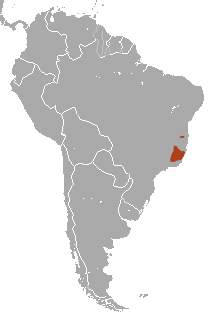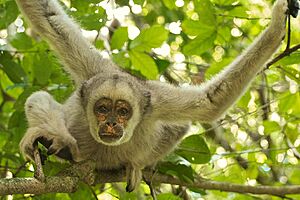Northern muriqui facts for kids
Quick facts for kids Northern muriqui |
|
|---|---|
 |
|
| Female and infant, in Caratinga, Brazil. | |
| Conservation status | |
| Scientific classification | |
| Genus: |
Brachyteles
|
| Species: |
hypoxanthus
|
 |
|
| Northern muriqui range | |
The northern muriqui (Brachyteles hypoxanthus) is a type of monkey found only in Brazil. People sometimes call them "woolly spider monkeys." This is because they have soft, woolly fur like woolly monkeys. They also have long, strong tails like spider monkeys.
Muriquis are the biggest monkeys in the New World (North and South America). They can grow to be about 1.3 meters (4.3 feet) long. They can weigh between 7 to 10 kilograms (15 to 22 pounds). Sadly, the northern muriqui is a critically endangered animal. This means there are very few left in the wild, maybe less than 1,000.
These monkeys are special because they are very friendly and fair in their groups. They live in the Atlantic Forest in parts of Brazil. Their food, how they travel, and when they have babies all change with the seasons. Female muriquis often move between different groups of monkeys.
Contents
What They Look Like
Northern muriquis have bodies that help them move easily through trees. They use all four of their limbs and their tail to swing from branch to branch. This way of moving is called brachiation. Their long, hook-like fingers and flexible shoulders help them swing far.
Even though they live mostly in trees, they sometimes come down to the ground. They might drink water, eat soil, or pick up ripe fruit that has fallen. You can tell individual northern muriquis apart by their unique faces. Their fur color, ear shape, and face marks are all different.
Unlike some other monkeys, male and female northern muriquis look very similar. They both have small, leftover thumbs. Their close relatives, the southern muriquis, do not have these thumbs at all.
Their Environment and Habits
What They Eat
Northern muriquis mainly eat fruits and leaves. But they also munch on seeds, flowers, nectar, bark, and even soil. They eat different things depending on the time of year. During the wet season, they eat more fruits because there are more available. Fruits give them lots of energy. In the dry season, they eat more leaves.
Larger groups of muriquis need to travel further to find enough food. Muriquis can find food at all levels of the forest, from the ground to the very top. Different groups of muriquis often have overlapping areas where they live. They avoid each other by using different parts of the forest to find food.
How They Live Together
Northern muriquis live in friendly groups where everyone is treated equally. Their groups can split into smaller parts and then come back together. Male muriquis usually stay with the group they were born into. Female muriquis, however, leave their birth group when they are about six years old. They join other muriqui groups.
Male muriquis often form close friendships with other males in their group. Older males and younger males might form different friend groups. But they usually work together, which means there are fewer fights within the group. This friendly behavior is clear during mating season. Males don't fight much over mating partners. They also don't fight much when they meet other muriqui groups.
When different muriqui groups meet, females can join a new group. They do this by making sounds and interacting with the new monkeys, like hugging them. Female muriquis are more independent than males. Males usually don't interact much with baby muriquis. If they do, the baby usually starts it. Female muriquis are often in charge of the social groups. Adult males stay close to their mothers, and this helps them find more female partners.
Reproduction and Life Cycle
The northern muriqui's breeding time depends on the seasons. Babies are usually born during the dry season. This means that when the wet season arrives, there will be lots of fruit. This helps the young monkeys get plenty of high-energy food when they start eating solid food.
It seems that female muriquis mate with several partners. This might help prevent fighting among males. It could also increase the chances of having babies. A female muriqui is pregnant for a little over seven months. You can tell if a baby is male or female about a week after it's born. Scientists don't know the exact average lifespan of northern muriquis. But some have been known to live for over 30 years!
Conservation Status
The northern muriqui is one of the most critically endangered primates in the world. This means it is at a very high risk of disappearing forever. The main threats to these monkeys are hunting and the destruction of their forest home. Their habitat, the Atlantic Forest, is being cut down and broken into smaller pieces.
Out of all the small groups of northern muriquis, only one group in Caratinga, Brazil, is thought to be safe for the next 100 years. These monkeys also have very little genetic diversity. This makes it harder for them to adapt and survive. In 2005, new research found more muriquis in other forests. This raised the estimated wild population from about 500 to 1,000 individuals.
Predators
Northern muriquis can be hunted by animals like ocelots, tayras, and some birds of prey. If a muriqui sees a danger or a predator, it will make loud calls. This warns the other monkeys in its group.
Why They Matter to Us
The northern muriqui is important for understanding human evolution. This is because they have very tolerant and equal relationships between males and females. This is similar to how human hunter-gatherer groups used to live. Most other primates have a clear pecking order. Group fighting is also very rare among muriquis.
Male muriquis who have more support from their mothers and female relatives tend to have more offspring. This idea supports something called the "grandmother hypothesis." This idea suggests that grandmothers help their families by supporting their children and grandchildren.
See also
- Feliciano Miguel Abdala Private Natural Heritage Reserve, a special place where these monkeys live.
Gallery






